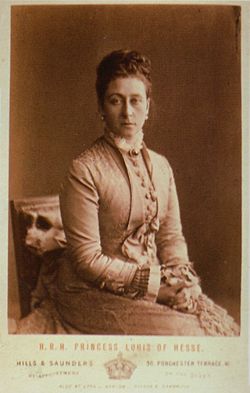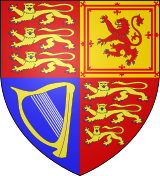Princess Alice of the United Kingdom
|
||||||||||||||||||||||||||||||||
|
||||||||||||||||||||||||||||||||

The Princess Alice (Alice Maud Mary; 25 April 1843 – 14 December 1878) was a member of the British Royal Family, the third child and second daughter of Queen Victoria. As the consort of Ludwig IV, Grand Duke of Hesse she was The Grand Duchess of Hesse.
Princess Alice was the great-grandmother of Prince Philip, Duke of Edinburgh, the consort of Queen Elizabeth II.
Contents |
Early life
Alice was born on 25 April 1843 at Buckingham Palace, London.[1] She was the second daughter and third child of the reigning British monarch, Queen Victoria, and her husband Prince Albert of Saxe-Coburg and Gotha. The name Alice was to honour Victoria's first Prime Minister, Lord Melbourne, who was still a passionate admirer of the Queen and who had once commented that the name “Alice” was his favourite female name.[2] Maud, the Anglo-Saxon name for Matilda, was chosen in honour of one of Alice's godparents, Princess Sophia Matilda of Gloucester, a niece of King George III. Mary was chosen because Alice was born on the same day as her great-aunt, Princess Mary, Duchess of Gloucester.[3] Alice was christened in the private chapel at Buckingham Palace by William Howley, the Archbishop of Canterbury, on 3 June 1843. Her gender was greeted with a mixture of feeling from the public and even the Privy Council sent a message to Albert expressing its “congratulation and condolence” on the birth of a second daughter.[2] The godparents selected by the Queen were Ernest Augustus I of Hanover for whom Prince Adolphus, Duke of Cambridge stood proxy; Feodora, Princess of Hohenlohe-Langenburg, for whom Princess Victoria, Duchess of Kent stood proxy; Ernest II, Hereditary Prince of Saxe-Coburg and Gotha. for whom Georg, Grand Duke of Mecklenburg-Strelitz stood proxy and Princess Sophia Matilda of Gloucester.[4]
Childhood
Alice's birth prompted her parents to find a bigger family home. Buckingham Palace was not equipped with the private apartments that Victoria's growing family needed, including suitable nurseries. Therefore, in 1844, Victoria and Albert purchased Osborne House on the Isle of Wight as a family holiday home. Alice's education was devised by her father and his close friend, Baron Stockmar. At Osborne, Alice and her other siblings were taught practical skills such as housekeeping, cooking, gardening and carpentry.[5] Victoria and Albert favoured a monarchy based on family values, and Alice and her siblings, who wore middle class clothing on a daily basis, slept in sparsely furnished bedrooms with little heating.[6] Alice was fascinated with the world outside the Royal Household, and at Balmoral, where she seemed happiest, she visited the tenants living and working on the estate. On one occasion, she escaped from her governess at the chapel at Windsor Castle and sat in a public pew, so she could better understand people who were not strict adherents to royal protocol.[7] In 1854, during the Crimean War, the eleven-year old Alice toured London hospitals for wounded soldiers with her mother and eldest sister.[8] She was the most emotionally sensitive of her siblings and was sympathetic to other people's burdens, which was matched by a sharp tongue and an easily triggered temper.[9]
In her childhood, Alice formed a close relationship with her brother, the Prince of Wales, and her eldest sister, Victoria, the Princess Royal. Although Alice shared a close companionship with her sister, and was upset when she married Prince Frederick of Prussia in 1858, she was closest to the Prince of Wales, with whom she held a tight and intimate bond.[10]
Family caregiver
Alice's compassion for other people's suffering established her role as the family caregiver in the year 1861. Her grandmother Victoria, Duchess of Kent, Queen Victoria's mother, died at Frogmore on 16 March 1861. Alice had spent much of her time at her grandmother's side, often played the piano for her in Frogmore's drawing room, and nursed her through the final illness.[11] Following her mother's death, the Queen broke down with grief and relied heavily on Alice, to whom Albert had given the instruction: “Go and comfort Mama.”[11] she wrote to her uncle, King Leopold of Belgium, that “dear good Alice was full of intense tenderness, affection and distress for me”.[12]
Only a few months later, on 14 December 1861, Albert died at Windsor Castle. During his final illness, Alice remained at his bedside. Alice sent for the Prince of Wales by telegram, without the knowledge of the Queen, who refused to notify him because she blamed him for Albert's death.[13] The Queen was distraught by her husband's death, and the court entered a period of intense mourning.[14] Alice became her mother's unofficial secretary, and through her passed the Queen's official papers to and from her government ministers.[15] Alice was aided in this task by her younger sister Princess Louise. Although Princess Helena, Louise's elder sister, would normally have been selected, her inability to go long without crying made her an inappropriate choice.[16]
Marriage
On 1 July 1862, Princess Alice married Prince Louis of Hesse and by Rhine (12 September 1837-13 March 1892), the son of Prince Charles of Hesse and by Rhine and the nephew of Louis III, Grand Duke of Hesse and by Rhine (9 June 1806-13 June 1877), at Osborne House on the Isle of Wight. On the day of the wedding, Queen Victoria issued Letters Patent granting her new son-in-law the style Royal Highness. This style was in effect in Great Britain, not Hesse.
Alice and Louis took up residence at Darmstadt, Hesse. The couple had seven children. It was later learned that Alice carried and passed on the haemophilia gene she inherited from Queen Victoria to several of her own children.
Issue
| Name | Birth | Death | Notes |
|---|---|---|---|
| Princess Victoria | 5 April 1863 | 24 September 1950 | Married Prince Louis of Battenberg, later Marquess of Milford Haven (24 May 1854-11 September 1921) and had issue. |
| Princess Elizabeth | 1 November 1864 | 18 July 1918 | Took the name Yelisaveta Fyodorovna on her baptism into the Russian Orthodox Church, m. Grand Duke Sergei Alexandrovich of Russia (11 May 1857-17 February 1905), son of Alexander II of Russia and had no issue. Had been courted by her cousin, William II, German Emperor, but rejected him. |
| Princess Irene | 11 July 1866 | 11 November 1953 | Married her cousin Prince Heinrich of Prussia, (14 August 1862-20 April 1929), son of Frederick III, German Emperor and had issue. Irene passed haemophilia on to two of her three sons: Prince Waldemar of Prussia and Prince Henry of Prussia. |
| Prince Ernest Louis | 25 November 1868 | 9 October 1937 | Became Grand Duke of Hesse and by Rhine, 13 March 1892; abdicated 9 November 1918; married his first cousin HRH Princess Victoria Melita of Saxe-Coburg and Gotha (25 November 1876-2 March 1936), divorced, had issue; married HH Princess Eleonore of Solms-Hohensolms-Lich (17 September 1871-16 November 1937) and had issue. |
| Prince Friedrich | 7 October 1870 | 29 May 1873 | Suffered from haemophilia and died from internal bleeding after a fall from a window at the age of two and a half. |
| Princess Alix | 6 June 1872 | 17 July 1918 |
Took the name Alexandra Feodorovna on her baptism into the Russian Orthodox Church, m. Tsar Nicholas II of Russia (18 May 1868-17 July 1918), and had issue. Their only son, Tsarevich Alexei, suffered from haemophilia. |
| Princess Marie | 24 May 1874 | 16 November 1878 | Died of diphtheria. |
Later life
Princess Alice's concern about the poor nursing conditions for wounded soldiers during the 1866 Austro-Prussian War, led her to found the Alice-Frauenverein, or Women's Union, to train nurses and auxiliary workers. She also helped found the Alice Hospital, which is still in operation in Darmstadt.
On 13 June 1877, Prince Louis succeeded his uncle as the reigning Grand Duke of Hesse and by Rhine and Princess Alice became the Grand Duchess. However, in November 1878, the Grand Duke and all but one of the children, Princess Elizabeth, fell ill with diphtheria. Elizabeth was sent to live with relatives. Princess Marie died of the disease. Alice had, despite warnings from the physicians, hugged and kissed her one surviving son when she told him of Marie's death.
Exhausted by nursing all of them, Alice succumbed to the disease and died at the New Palace in Darmstadt on 14 December, the anniversary of her father's death. Alice is buried at Rosenhöhe, the mausoleum for the Grand Ducal House of Hesse outside Darmstadt. Prior to her death she spent a few weeks in Eastbourne, East Sussex recuperating. In 1882 the Princess Alice Memorial Hospital was set up in the town in her honour.[17]
Titles, styles, honours and arms
Titles and styles
- 25 April 1843 – 1 July 1862: Her Royal Highness The Princess Alice
- 1 July 1862 – 13 June 1877: Her Royal Highness Princess Louis of Hesse and by Rhine
- 13 June 1877 – 14 December 1878: Her Royal Highness The Grand Duchess of Hesse and by Rhine
Arms
In 1858, Alice and her three younger sisters were granted use of the royal arms, with an inescutcheon of the shield of Saxony, and differenced by a label argent of three points. On Alice's arms, the outer points were ermine, and the centre bore a rose gules.[18]
Ancestors
| Ancestors of Princess Alice of the United Kingdom | ||||||||||||||||||||||||||||||||||||||||||||||||||||||||||||||||||||||||||||||||||||||||||||||||||||||||||||||||||||||||||||||||||||||||||||||||||||||||||||||||||||||||||||||||||||||||||||||||||||||||||||||||||||||||||||||||||||||||||||||||||||||||||||||||||||||||||||||||||||||||||||||||||||||||||||||||||||||||||||||||||||||||||||||||||||||||||||||||||||||||||||||||||||||||||||||||||||||||||||||||||||||||||||||||||||||||||||||||||||||||||||||||||||||||||||||||||||||||||||||||||||||||||||||||||||||||||||||||||||||||||||||||||||||||||||||||||
|---|---|---|---|---|---|---|---|---|---|---|---|---|---|---|---|---|---|---|---|---|---|---|---|---|---|---|---|---|---|---|---|---|---|---|---|---|---|---|---|---|---|---|---|---|---|---|---|---|---|---|---|---|---|---|---|---|---|---|---|---|---|---|---|---|---|---|---|---|---|---|---|---|---|---|---|---|---|---|---|---|---|---|---|---|---|---|---|---|---|---|---|---|---|---|---|---|---|---|---|---|---|---|---|---|---|---|---|---|---|---|---|---|---|---|---|---|---|---|---|---|---|---|---|---|---|---|---|---|---|---|---|---|---|---|---|---|---|---|---|---|---|---|---|---|---|---|---|---|---|---|---|---|---|---|---|---|---|---|---|---|---|---|---|---|---|---|---|---|---|---|---|---|---|---|---|---|---|---|---|---|---|---|---|---|---|---|---|---|---|---|---|---|---|---|---|---|---|---|---|---|---|---|---|---|---|---|---|---|---|---|---|---|---|---|---|---|---|---|---|---|---|---|---|---|---|---|---|---|---|---|---|---|---|---|---|---|---|---|---|---|---|---|---|---|---|---|---|---|---|---|---|---|---|---|---|---|---|---|---|---|---|---|---|---|---|---|---|---|---|---|---|---|---|---|---|---|---|---|---|---|---|---|---|---|---|---|---|---|---|---|---|---|---|---|---|---|---|---|---|---|---|---|---|---|---|---|---|---|---|---|---|---|---|---|---|---|---|---|---|---|---|---|---|---|---|---|---|---|---|---|---|---|---|---|---|---|---|---|---|---|---|---|---|---|---|---|---|---|---|---|---|---|---|---|---|---|---|---|---|---|---|---|---|---|---|---|---|---|---|---|---|---|---|---|---|---|---|---|---|---|---|---|---|---|---|---|---|---|---|---|---|---|---|---|---|---|---|---|---|---|---|---|---|---|---|---|---|---|---|---|---|---|---|---|---|---|---|---|---|---|---|---|---|---|---|---|---|---|---|---|---|---|---|---|---|---|---|---|---|---|---|---|---|---|---|---|---|---|---|---|---|---|---|---|---|---|---|---|---|---|---|---|---|---|---|---|---|---|---|---|---|---|---|---|---|---|---|---|---|---|---|---|---|---|---|---|---|---|---|---|---|---|---|---|---|---|---|---|---|---|---|---|---|---|---|---|---|---|---|---|---|---|---|---|---|---|---|---|---|---|---|---|---|---|---|---|---|---|---|---|---|---|---|---|---|---|---|---|---|---|---|---|---|---|---|---|
|
||||||||||||||||||||||||||||||||||||||||||||||||||||||||||||||||||||||||||||||||||||||||||||||||||||||||||||||||||||||||||||||||||||||||||||||||||||||||||||||||||||||||||||||||||||||||||||||||||||||||||||||||||||||||||||||||||||||||||||||||||||||||||||||||||||||||||||||||||||||||||||||||||||||||||||||||||||||||||||||||||||||||||||||||||||||||||||||||||||||||||||||||||||||||||||||||||||||||||||||||||||||||||||||||||||||||||||||||||||||||||||||||||||||||||||||||||||||||||||||||||||||||||||||||||||||||||||||||||||||||||||||||||||||||||||||||||
See also
- Haemophilia in European royalty
References
- ↑ Packard, p. 25
- ↑ 2.0 2.1 Packard, p. 26
- ↑ Princess Christian, p. 13
- ↑ London Gazette: no. 20231, page 1889, 6 June 1843. Retrieved on 2008-03-31.
- ↑ Van der Kiste, p. 22
- ↑ Van der Kiste, p. 23
- ↑ Packard, p. 64
- ↑ Van der Kiste, p. 28
- ↑ Packard, p. 50
- ↑ Packard, p. 51
- ↑ 11.0 11.1 Packard, p. 87
- ↑ Benson, p. 66
- ↑ Magnus, p. 52
- ↑ Zeepvat, p. 42
- ↑ Packard, p. 102
- ↑ Packard, 102
- ↑ The Illustrated London News, No.2254 — Vol. LXXXI, Saturday, July 15, 1882, p.66 (found at [1])
- ↑ Heraldica – British Royalty Cadency
|
||||||||||||||||||||||||||||||||||||||

